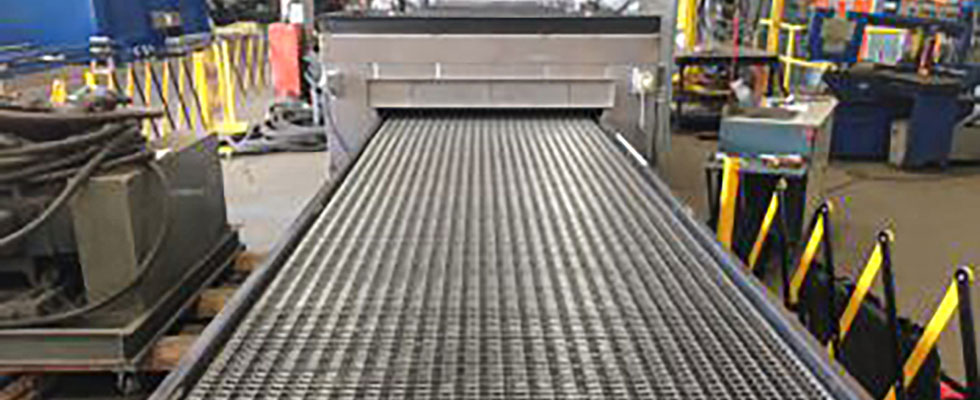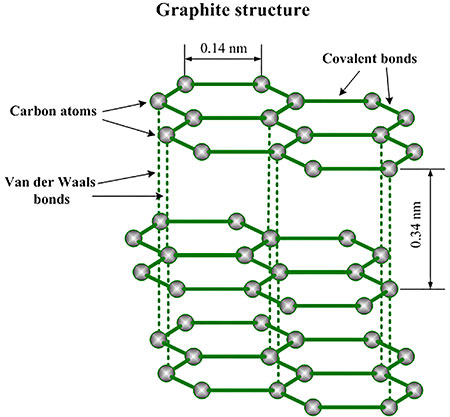
Carbon graphite is employed by businesses to decrease costs, improve efficiency and ensure public safety across the food processing industry. Carbon graphite’s mechanical/chemical properties and its sanitary attributes make it a material to consider when designing conveyor ovens, blanchers and sterilization equipment, to name a few. This article will highlight some of the key aspects of carbon graphite that make it such a versatile material in the food and beverage industry.
Carbon graphite is a useful material for a plethora of reasons. The first is that carbon graphite is self-lubricating. The molecular structure of carbon graphite is made up of layers of carbon atoms held together by Van der Waals bonds between them. These bonds are weaker than other types of chemical bonds and allow the material to easily move over the counter face it runs against.

IMAGE 1: Molecular structure of graphite (Images courtesy of Metallized Carbon Corporation)
Molecular Structure of Graphite
The self-lubricating characteristics of carbon also give it the ability to run dry if no operating fluid is present. As one can imagine, removing the need for oil or grease lubrication in food processing and handling equipment is invaluable in alleviating serious health concerns.
The next major property benefit of carbon graphite is that it can be impervious and have no porosity. Plain carbon graphite has an interconnected network of porosity from outgassing. The available porosity can be filled with various types of metals, resins and salts through a vacuum impregnation process. This is done to make it so carbon graphite material will not have any foreign materials absorbed into it during operation. This is beneficial in food processing applications because it prevents bacteria from growing inside the carbon graphite. Additionally, removing porosity allows carbon graphite to be easily cleaned and sanitized.
The next property that carbon graphite has is the wide delta temperature range the material can operate in. Two examples of this one on both ends of the spectrum are in conveyor ovens and freezer conveyors. For conveyor ovens, the hot zones can reach upwards of 600 F. Bearings made from engineered plastics fail at approximately 350 F.
High-temperature grease lubricants can be expensive, and the daunting task of constantly needing to replace this grease on hundreds of bearings cannot be overlooked. Carbon graphite offers a material that can operate in temperatures as high as 850 F. In freezer conveyors, the operating temperatures in the coolant system can reach as low as -400 F. This would prevent bearings made from traditional materials from being used because the grease needed for lubrication would have increased viscosity, potentially causing them to seize. Carbon graphite’s self-lubricating properties are not hindered in these subzero operating temperatures.
The last property that carbon graphite has that makes it an optimal choice for food processing/handling applications is the material’s chemical resistance.
Some examples of this are citrus fruit peelers, squeezers and juicers.
When processing foods, it is likely that some components will encounter some acidic liquids from citrus fruits such as oranges and lemons. The constant exposure to these citric acid liquids will cause corrosion over time to many different materials but will not affect carbon graphite. Carbon graphite is an inert material that can come into regular contact with some of the most caustic acids, such as hydrofluoric and sulfuric acid without having adverse chemical reactions.
Carbon graphite has also received approvals to be used in the food industry. The two major agencies that have given it approvals are the United States Food and Drug Administration (FDA) and National Sanitation Foundation (NSF). The FDA has ruled that impervious carbon graphite is considered generally recognized as safe (GRAS) for use in food handling equipment. The NSF has listed some carbon graphite under the NSF-51 Standard for Food Equipment Materials. This standard outlines the requirements for materials to be used in commercial food equipment.
Carbon graphite has the required properties and agency approvals to be used in the food processing industry. It is well tailored for these applications with its ability to be self-lubricating, withstand a wide temperature range and remain sanitary and bacteria-free.

